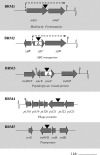Insertional mutagenesis to generate lantibiotic resistance in Lactococcus lactis
- PMID: 17526796
- PMCID: PMC1932815
- DOI: 10.1128/AEM.02351-06
Insertional mutagenesis to generate lantibiotic resistance in Lactococcus lactis
Abstract
While the potential emergence of food spoilage and pathogenic bacteria with resistance to lantibiotics is a concern, the creation of derivatives of starter cultures and adjuncts that can grow in the presence of these antimicrobials may have applications in food fermentations. Here a bank of Lactococcus lactis IL1403 mutants was created and screened, and a number of novel genetic loci involved in lantibiotic resistance were identified.
Figures


References
-
- Abachin, E., C. Poyart, E. Pellegrini, E. Milohanic, F. Fiedler, P. Berche, and P. Trieu-Cuot. 2002. Formation of D-alanyl-lipoteichoic acid is required for adhesion and virulence of Listeria monocytogenes. Mol. Microbiol. 43:1-14. - PubMed
-
- Ansanay, V., S. Dequin, B. Blondin, and P. Barre. 1993. Cloning, sequence and expression of the gene encoding the malolactic enzyme from Lactococcus lactis. FEBS Lett. 332:74-80. - PubMed
-
- Bandell, M., V. Ansanay, N. Rachidi, S. Dequin, and J. S. Lolkema. 1997. Membrane potential-generating malate (MleP) and citrate (CitP) transporters of lactic acid bacteria are homologous proteins. Substrate specificity of the 2-hydroxycarboxylate transporter family. J. Biol. Chem. 272:18140-18146. - PubMed
-
- Bonnet, M., and T. J. Montville. 2005. Acid-tolerant Listeria monocytogenes persist in a model food system fermented with nisin-producing bacteria. Lett. Appl. Microbiol. 40:237-242. - PubMed
Publication types
MeSH terms
Substances
LinkOut - more resources
Full Text Sources
Medical

